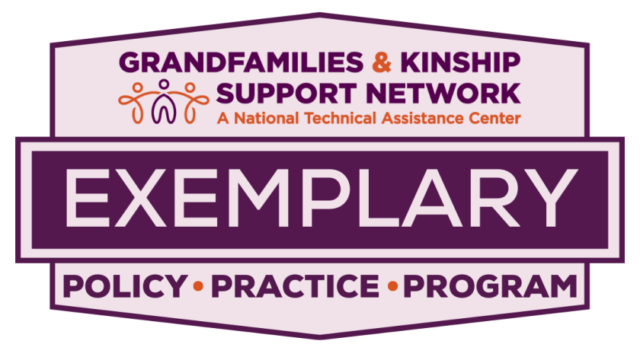Tip Sheet
Improving Support for Kinship/Grandfamilies: State Strategies for TANF Child-Only Grants and Related Assistance
Download This Resource

One of the four primary purposes of Temporary Assistance for Needy Families (TANF) is “to provide assistance to needy families so that children may be cared for in their own homes or in the homes of relatives.” 42 U.S.C. § 601
In 1996, Congress explicitly intended TANF as a critical support for kinship/grandfamilies – families in which children are being raised by kin who are their grandparents, other relatives, or close family friends. Almost three decades later, kin continue to rely on TANF as often the only source of ongoing financial support for helping them meet the needs of children they did not plan to raise.
While much of the nation’s TANF caseload consists of TANF child-only grants to children being raised by relatives, the program remains underutilized by these families. Only about 13 percent of children in kinship families receive TANF child-only, despite most being eligible, since these grants are designed to consider only the child’s income. Many eligible children do not access or receive this support because their caregivers and TANF agency staff often do not know about TANF child-only grants. Even if they do, the application process is typically confusing and poses barriers to families, making child-only difficult to access.
Each state has the power to improve TANF child-only access and other support for kinship families. As TANF is a federal block grant program, each state receives a set amount of funding for its TANF grants and services, and each state has a great deal of flexibility in how it designs its overall program, starting with what it calls its TANF program and how it refers to child-only grants. Some states refer to their TANF programs by different names, including TEA (Arkansas), CalWorks (California), and TAFI (Idaho). Child-only grants might be referred to as “non-needy” (Nevada and Washington) or “specified relative” (Texas). Among the many other aspects within each state’s discretion are who the state considers a “relative,” what the monthly maximum grant amounts are, and how child support from the child’s parents will be pursued and processed.
In this piece, we aim to provide states with replicable practices and policies to improve access to TANF child-only benefits, so that kinship families stay together and children do not need to enter the legal custody of the more costly child welfare system simply because their caregivers cannot afford to meet their needs.
This piece does not address Tribal TANF, although there are many good practices to learn from tribes. We include one example from the Port Gamble S’Klallam Tribe below. See this brief from the Center on Budget and Policy Priorities for additional information about Tribal TANF.
Given that the entire foster care system in the United States consists of about 343,000 children, that system would be completely overwhelmed if even a fourth of the 2.4 million children being raised by grandparents and other kin needed to enter traditional foster care. Translated to dollars, if 600,000 children being raised by kin were to enter foster care, it would cost U.S. taxpayers over $10.5 billion each year. This very conservative calculation deducts TANF child-only grants received by kinship families and does not include the associated court, administrative, and oversight costs that are necessary when a state agency formally removes a child from their parents and places them in government custody.
While many states are laudably pursuing kin-first cultures in their child welfare agencies and taking the option to have separate, commonsense foster care licensing for relatives, the vast majority of kinship families have no foster care involvement and are increasingly asking how states can help them keep their families together. Many kinship families struggle with the unexpected costs of raising children they did not plan to raise. The majority of kin caregivers are in the workforce, and they may need childcare when stepping up to raise children. Also, their income may not stretch to feed, clothe, educate, and provide for the children’s many other basic needs. Almost half of all kin caregivers are over age 60. Those caregivers may depend on their Social Security, but it often does not extend to the children.
To help meet the needs of children, TANF child-only grants were envisioned as, and remain, a critical source of ongoing financial support. We begin this piece with some of the key barriers that hinder TANF child-only access, before sharing replicable state strategies for overcoming those barriers and enhancing access and supports for kinship/grandfamilies.
Key Barriers to Accessing TANF Child-Only Grants
Hidden Support and Confusing Application Process
The TANF child-only grant is a hidden support in many states. Kinship families often do not know it is available to help them meet the needs of the children in their care. These grants are rarely called out by name or explained on state websites or outreach materials. To compound the problem, TANF agency staff are typically not trained on kinship families or how to process their applications for child-only grants.
To our knowledge, no state has a separate child-only application. Families must apply for child-only grants using the TANF family grant application process. Family grant applications ask for caregiver income information, and they usually ask for asset information, often allowing only $3,000 in retirement savings, even for older caregivers. To apply for the child-only grant, caregivers need to know which fields to complete on the family grant application, and which to ignore. Agency staff may not know how to process these applications, and stories abound of kin caregivers being turned away and denied this support.
Requirements to Assign Child Support Collection
If the caregiver discovers TANF child-only and gets as far as the application process, they must then typically assign their right to child support to the state. This requirement is what stops many caregivers from applying for this important source of financial support. Caregivers often do not want to give the state the power to pursue the child’s parents – who may be their adult children or other close relatives. To collect child support, the state may garnish the parents’ wages, revoke their driver’s or business licenses, and even issue arrest warrants, all of which jeopardize parents’ ability to reunify with their children. Other caregivers may be fearful that when the state tries to locate the parents, the parents may become angry and perhaps take the child into an unsafe situation or become violent towards the caregiver. States have federal flexibility to waive this child support requirement for “good cause” or to create different requirements for caregivers who are not the child’s parents.
Federal law does not require child support cooperation from people who are not the child’s parents. States have discretion to develop their own policies around cooperation for individuals such as grandparents and other relatives, acknowledging that they may not have the same information about the absent parent as the child’s other parent. TANF Final Rule, 64 FR 17850 (April 12, 1999).
Adults with a Family-Like Relationship to the Children
States have flexibility to define “relative” for the purposes of TANF, and most do not include non-related adults with a family-like relationship to the children, such as godparents. On the other hand, most state child welfare agencies include non-relatives with a preexisting bond with the child or family as “relatives” for the purposes of separate foster care licensing and guardianship assistance. This variation between systems creates further confusion among families and service providers.
State Strategies
Several state TANF agencies have practices and policies that support kinship families, which other states can learn from and replicate.
Implement state practices to improve awareness of TANF child-only support:
- If possible, create a separate, easy-to-complete TANF child-only application. If a separate application is not feasible, amend the TANF family grant application to include instructions for applying for child-only or create a video and provide clear instructions on how relative caregivers can apply for child-only using the existing TANF family grant application that asks for caregiver income information. See low-cost video examples from Nevada’s Foster Kinship and New York State’s Kinship Navigator Program.
- Mention TANF child-only grants by name and provide eligibility information on relevant state agency websites. Very few state agency websites mention the “child-only” grants by name or explain what they are. As one kinship service provider told us, “it’s the state’s best kept secret.” See these examples from the Idaho Department of Health & Welfare and the South Carolina Department of Social Services, which call the grant by name and clearly explain who is eligible. The Texas Health and Human Services Commission has a helpful three-page flyer linked from their website, called Help Raising Children Related to You.
- Provide training to TANF staff and kinship navigators to raise awareness of child-only grants for kinship families. See this PowerPoint training template from the Grandfamilies & Kinship Support Network that you can use free of charge and tailor to your own state requirements.
- Partner with your kinship navigator program and provide kin caregivers with the option to sign permission to contact forms that allow the kinship navigator to contact the caregiver and help them complete the application for TANF child-only.
Replicate state policies that eliminate barriers to TANF child-only support:
- Use the federal “good cause” exemption for relative caregivers, thereby not requiring child support assignment to the state. Massachusetts and Wyoming exempt all relative caregivers from these requirements.
- Expand state TANF definitions of “relative” to include non-related kin. Colorado and Vermont are among the few states that allow kin who are not related to the child to receive TANF child-only on the child’s behalf without requiring a legal relationship, emergency, or child welfare placement. Connecticut and Wisconsin allow non-related adults raising children to receive TANF child-only grants for the children if they have obtained or are seeking legal custody or guardianship of the children. In Nevada, non-related kin can qualify for a child-only (or non-needy) grant for up to six months while they are pursuing foster care licensure. For each state’s definition of “relative,” see here.
Review and address problematic state practices that limit access to TANF child-only support:
- Do not test caregiver income or assets in determining a child’s eligibility for TANF child-only grants. Remain consistent with federal law and intent and virtually all other states by not imposing these additional requirements. Arizona, Nevada, and Oregon are the only states we know of that test caregiver income to determine child-only eligibility. No states are known to test caregiver assets for TANF child-only grants.
- Check your state policies to ensure you do not have a policy making children ineligible for child-only grants for a defined period of time after they were included on a TANF family grant that exhausted its time-limited benefits. While rare, there are some states that have what is often referred to as a “grandparent penalty.”
Consider increasing TANF child-only monthly benefit amounts for each child:
- Increase the child-only amount to mirror or more closely match foster care maintenance payment amounts. TANF child-only grants start as low as $81 per month for the first child, with a national monthly average of only $328 for the first child, while the average monthly foster care maintenance payment to help relative foster parents meet the needs of the children they care for is $915 per child.1 See “Uneven Support for Kinship/Grandfamilies: State TANF Child Only Grants,” published by Child Trends and the Grandfamilies & Kinship Support Network, for more information.
- Make the child-only amount per child like foster care maintenance payments, as opposed to only incrementally increasing the amount for each additional child. Incremental increases make it very challenging for relative caregivers to keep sibling groups together. Port Gamble S’Klallam Tribe provides per-child grant amounts for its non-needy (child-only) grants. For state data on these incremental increases, see “Uneven Support for Kinship/Grandfamilies: State TANF Child Only Grants.”
Leverage state TANF funds to further support children and their kinship families:
- Provide enhanced, ongoing financial support to relative caregivers with low incomes. Louisiana and Nevada use their TANF block grants to offer specific programs for kinship families with low household incomes. These programs exist in both states as an alternative to TANF child-only and TANF family grants. They provide larger, ongoing monthly benefit amounts than child-only, and they do not impose time limits and work requirements as their states’ TANF family grants do.
- Since 1999, Louisiana has used TANF funds to offer its Kinship Care Subsidy Program, which provides a monthly subsidy of $450 per child to qualified relatives with incomes less than 150% of the federal poverty level who are caring for children outside the foster care system.
- Kinship families in Nevada may qualify for its Kinship Care Program, which uses TANF funds to provide monthly cash assistance of over $400 per child. The Nevada program is for relative caregivers age 62 and older who have obtained guardianship of the children and have household incomes less than 275% of the federal poverty level. In addition to the monthly payments, Nevada reimburses caregivers up to $750 for legal expenses they incurred to obtain guardianship of the children they are raising.
- Create an extra TANF payment for grandparent and other relative caregivers. In Texas, a one-time $1,000 TANF supplement is available to grandparents, aunts, uncles, sisters, and brothers. The relative must be over 25 years of age and meet income and asset eligibility requirements. This one-time payment to the family can help pay for an array of expenses, including clothing, laundry, housing, utilities, and furniture.
- Designate TANF short-term assistance for kinship families. KinShare in Alabama is short-term TANF assistance to relative caregivers whose income is at or below 200% of the federal poverty guidelines. Caregivers related to the child by blood, marriage, or adoption can receive up to $500 per year to help pay for rent, utilities, mandatory school expenses, household furniture, court costs, and counseling. New Jersey’s Kinship Wraparound Program provides relatives or legal guardians whose income is at or below 250% of the federal poverty guidelines with up to $500 per year to pay for furniture; clothes; computers; and opportunities to participate in sports and non-sporting activities such as tutoring, summer camps, or other extracurricular activities.
- Provide legal assistance using TANF block grant funds. Legal Aid Of West Virginia receives TANF state block grant funds to provide legal services to kin caregivers who receive TANF child-only benefits.
- Help finance your kinship navigator program. Louisiana’s Kinship Navigator Program is using TANF funds to support its services, offered through a statewide network of Family Resource Centers.
We’re Here to Help
As the only national technical assistance center on kinship families, we are available to provide no-cost assistance to help you implement any or all of these strategies.
- Child Trends analysis of AFCARS 2021 data; USDHHS. (2022). Adoption and Foster Care Analysis and Reporting System (AFCARS): FY 2021 foster care file. U.S. Department of Health and Human Services, Administration for Children and Families, Children’s Bureau. https://www.ndacan.acf.hhs.gov/datasets/dataset-details.cfm?ID=274 ↩︎


